
The two most popular Asian exchanges are Binance and KuCoin and both were based in China. After Chinese government banned digital currency exchanges, they both moved to Hong Kong, while Binance later on moved on to Malta even though current reports from TheBlock claim that Binance is not incorporated there but rather on some other, hitherto unknown location (if anywhere).
In this article we will try to present both exchanges’ advantages and disadvantages, head to head, to give you idea which one could suite you more.
Let’s begin this Kucoin vs Binance comparison by looking into Binance and what it offers. We will then move onto Kucoin and conclude the Binance vs Kucoin duel at the end.
Visit Binance Now Visit KuCoin Now
Binance has ✅ more liquidity than any other exchange in the world ✅ Low trading fees ✅ wide range of coins for trading – more than 1000 trading pairs ✅ User verification process fairly simple
On the other hand, Binance is ❌ not regulated ❌ often scraps some of its popular features due to the regulatory pressure ❌ its BNB token is very dubious and appears to be a money grab by Binance’s founder CZ. ❌ it is not available in the US and its Binance US version is severely lacking in comparison to the main platform.
Kucoin is much smaller but still a worthy opponent. It has ✅ an extremely large selection of altcoins available for trade – 700 trading pairs ✅ Integration with the Arwen protocol enables a higher degree of security for traders ✅ Low fees for trading and withdrawals ✅ Available in the US
Where it falls short is its ❌Relatively low liquidity. It is also ❌ not regulated.
Fees are 0.1% on both websites and both exchanges have their own tokens. BNB from Binance is used to reduce the fees you pay on the platform, while the KCS from KuCoin pays you dividens on exchange’s earnings.
What you'll learn 👉
Binance
Binance (Binary + Finance = Binance) is the largest crypto exchange. It used to be crypto only exchange back in the day but it is a fully fledged crypto ecosystem today. You can deposit fiat via dozens of payment methods, trade more than 500 listed coins, do spot, margin, futures and option trading, earn crypto through Binance staking and savings, buy and sell via Binance P2P marketplace and even create and trade NFTs on its newly launched NFT marketplace. Binance also has its own trading bots.
Binance also has its own crypto credit card. While it is still unavailable in large parts of the world, it is one of the best crypto cards you can get.

Estimations made by divers crypto analyst firms claim that Binance has more than 30 million users.
Binance User Interface
There are two types of User Interfaces on Binance, basic and advanced. In the basic version of UI, you can see currency pairs trading, graphs and charts, trade history and order book.
In the advance version, you can also see currency pairs, open orders, trade history, but the advanced version offers more-in-depth technical analysis of crypto assets value over time.
Binance Fee Structure
Binance’s fee structure is divided into three categories:
- Fee for trading:
– 0.1% trading fee
- Fee for deposit is zero.
- Fee for Withdrawal: For each coin there is minimum amount required for withdrawal and different fee applies. For instance, minimum withdrawal amount for Bitcoin (BTC) is 0.002 and transaction fee is 0.001 BTC. Or minimum withdrawal amount for NEO is 1 and fee is equal to zero. Also withdrawal fee for GAS is zero. The withdrawal fee are adjusted according to the blockchain conditions on regular basis.
If you choose to pay your fees with the Binance native currency (BNB), you are entitled to a 25% reduction in fees, so that is a 0.075% maker/taker fee. This is slightly better than the 0.08% offered by KuCoin when you pay with their KCS.

Binance Trading Volume
According to the web site CoinMarketCap, at the moment of writing, Binance was ranked at number one on both types of exhanges: spot and derivatives with daily trading volume of $28,290,506,152 on spot and $72 billion on derivatives.
Binance Coin (BNB)
BNB is a Binance’s native token that used to be a ERC20 based on the Ethereum blockchain. Once Binance launched its own Binance Smart Chain and Binance Chain, BNB is now available on all three chains as an ERC20 and BEP20 token. You can use BNB to pay for any fees on Binance platform such as exchange fees, withdraw fees, listing fees and any other fee.
Initially, total supply of BNB was 200,000,000 coins. Binance will use 20% of profits, each quarter to buy back BNB and destroy them, until they buy 50% of all the BNB (100 million) back. All buy-back transactions will be announced on the blockchain. Binance will eventually destroy 100 million BNB, leaving 100 million BNB remaining.
KuCoin
According to their web site, Kucoin was founded by a group of blockchain enthusiasts who had proved themselves in industry giants like Ant Financial and GF Securities and aims at providing users digital asset transaction and exchange services which are even more safe and convenient, integrating premium assets worldwide, and constructing state of the art transaction platform.
KuCoin is essentially a poor man’s Binance. They have almost all features like Binance: crypto card, lending, staking, savings, P2P marketplace, margin and futures trading and trading bots.
KuCoin User Interface
After you have chosen currency pair to trade, the trading screen opens up. At the trading screen you can view the usual candles, order book, trade history and can then buy or sell the selected currencies. When you first enter this screen you will be prompted for your Google Authenticator code before being able to trade, this can be a little annoying but does add an extra layer of security to the site and we highly recommend it.
KuCoin Fee Structure
KuCoin’s fee structure is divided into three categories:
- Trading fees: 0.1% (KuCoin charge from the asset you bought)
- Deposit fees: zero.
- Withdrawal fees: For each crypto asset different fee applies. For instance, BTC withdrawal fee is fee is 0.001 BTC. While withdrawing NEO is free. Also withdrawal fee for GAS is zero. Note: If the amount of your withdraw proposal is less than CUREENT FEE * 100000, then this withdrawal will be processed automatically, usually takes seconds to complete. For example, withdraw fee of BTC is 0.0005, so if your withdraw less than 0.0005*100000=50 BTC, your request get fulfilled in a flash.
If you choose to pay in their native currency (KCS), in which case both reduce to 0.08%. To get to the next fee level, you need to trade at least a total value of 50 BTC or hold 1000 KCS for the previous 30 days.
KuCoin Trading Volume
KuCoin is ranked at place 6 based on daily trading volume for spot trading with around $1.5 billion daily trading volume. It is much lower when it comes to derivative exchanges, out of the top 20.
There is total of 700 crypto coins traded on KuCoin at the moment.
KuCoin Shares (KCS)
Kucoin Shares or KCS for short, is the token issued by Kucoin Cryptocurrency Exchange Platform with total supply of 200 million. After buy-back disposal, it will be a constant – 100 million. At least 10% of the KuCoin’s net profit will be applied to the buy-back of KCS every quarter. The KCS retrieved through buy-back will be destroyed immediately. The process will continue until 100 million KCS are destroyed.
As a decentralized cryptocurrency issued on the basis of Ethereum, also a standard ERC 20 token based on Ethereum blockchain, KCS supports all the Ethereum wallets.
Read our updated guide on best bitcoin bots.
KCS Bonus is regarded as one of the best ways to get passive income. Users who hold more than 6 KCS can get a daily dividend, which comes from 50% of KuCoin’s daily trading fee revenue. KCS Bonus is a unique incentive mechanism for KCS holders and KuCoin ecosystem builders. The amount of rewards that users can get depends on the number of KCS held and the trading volume of the KuCoin Exchange.
A US based, large volume trader that likes to trade a lot of small altcoins and take risks with 10x leverages.
Supported cryptocurrencies
There are more than 1000 trading pairs on Binance, while KuCoin is not far behind with its 700 trading pairs. Both platforms also have support for the largest fiat currencies such as USD, EUR and GBP.
Payment methods
You can deposit any of the available crypto coins on Binance or some of the supported fiat currencies (more than 20). Deposit methods for fiat currencies depend on the region you come frome and include debit and credit cards, direct transfers, diverse online payment services, ACH transfers, SWIFT transfers and SEPA transfers.
KuCoin has a similar offer with a slightly shorter list of available payment methods for fiat currencies.
Futures Market fees
Binance came out on top of this comparison. In the futures market, Binance has a marker/taker fee of 0.02%/0.04% compared to KuCoin, which has a 0.02%/0.06% fee. As you move through the futures tiers, Binance’s superior taker fee remains the better option.
Verdict: For a high volume trader, KuCoin is a clear winner here. For a small trader that remains at the low tiers, Binance is slightly better, but only when you pay your fees with their BNB coin.
Kucoin vs Binance fees? If you’re going to use the futures market, Binance is a clear winner, as it has a far better taker fee.
Safety – Which is safer?
Another close battle. Both are seen as secure exchanges as they suffered only one major hack, each.
Binance started in China and KuCoin started in Hong Kong, both left their original HQs due to regulatory landscape. It is hard to pinpoint exactly where each is domiciled but it seems Binance has its HQ in Malta and KuCoin in Singapore, although you can find mentions of Japan, Seychelles, Hong Kong, Cayman Islands, and more.
Both exchanges are not regulated and are operating in grey areas of regulations and are purposely avoiding strict regulations. This is both bad and good from the perspective of the customer. It is bad because a lack of regulation means a lack of compliance and, therefore, fewer safety procedures to keep your money safe, and good because less investment in compliance officers and regulation means more profits, which reduces the chance of them going bankrupt. Having said that, it is hard to see them do anything except grow and become giants in this young industry. In short, they’re both safe options.
Verdict: Draw, both KuCoin Binance have similar regulation and compliance situations. Due to market share, it’s extremely unlikely either of these will do anything other than grow their business. Your funds are safe!
Both Kucoin and Binance were hacked. KuCoin was hacked to the tune of $281 million in September 2020, while Binance suffered a $40 million hack in May of 2019.
Customer Service
Kucoin has incredibly fast customer service. There’s a 24-hour telegram support chat with quick response rate. Binance also offers different ways to contact its support, with the main one being through tickets. There are reports of it taking up to a few days, with a Reddit user claiming it took him as long as two weeks to get an answer, but apart from that, it is an above average customer service compared to most exchanges.
Conclusion – KuCoin or Binance
After going through specific parts of two ex-China based exchanges, we can see the pros and cons of both.
Binance has ✅ more liquidity than any other exchange in the world ✅ Low trading fees ✅ More than 1000 trading pairs ✅ User verification process fairly simple
On the other hand, Binance is ❌not regulated ❌often scraps some of its popular features due to the regulatory pressure ❌its BNB token is very dubious and appears to be a money grab by Binance’s founder CZ. ❌it is not available in the US and its Binance US version is severely lacking in comparison to the main platform.
Kucoin is much smaller but still a worthy opponent. It has ✅ an extremely large selection of trading pairs available (700+) ✅ Integration with the Arwen protocol enables a higher degree of security for traders ✅ Low fees for trading and withdrawals ✅ Available in the US
Where it falls short is its ❌Relatively low liquidity
When it comes to User Interface, Binance has two versions, basic and advanced. They are both great looking and slick, offering views of trade history, order book, currency pairs. The advanced version offers more-in-depth technical analysis of crypto assets value over time.
KuCoin’s User Interface is also great. They improved it at the end of 2017, but you can still change UI to the old version on their web site.
KuCoin fees vs Binance? The fee structure of both exchanges are similar, transaction fee is 0.1%, deposit is free. On the withdrawal side, Binance requires a certain minimum amount for withdrawal, while KuCoin does not.
Binance also offers 50% discount of transaction fee, if you use their token for paying the fees.
Looking at the daily trading volume, Binance is the clear winner. Binance is the number one in trading in the crypto world. On the other side, KuCoin occupies 26th place based on daily trading volume.
Binance is supporting over 1000 digital coins compared to KuCoin’s 700. But KuCoin is fast in supporting new and exciting coins adding space to trading opportunities for its users.
Both exchanges are great, they are very popular and fast growing with great user interfaces. Both support massive number of crypto assets and have great or good daily trading volumes.
So if you are looking for greater liquidity pool, you should go with Binance, but if your are looking for new and exciting crypto assets than go for KuCoin.
We suggest you use both of these great exchanges.
If you are not fond of neither of these exchanges, here is a list of potential alternatives: Coinbase, Cex.io, PrimeXBT, PrimeBit, Deribit, Coinbase Pro, Coinmama, Changelly, Bitpanda, Bitfinex, Kraken, Bittrex, Bitstamp.
In case you want to compare Binance with other exchanges, have a look at our guides where we do just that:







